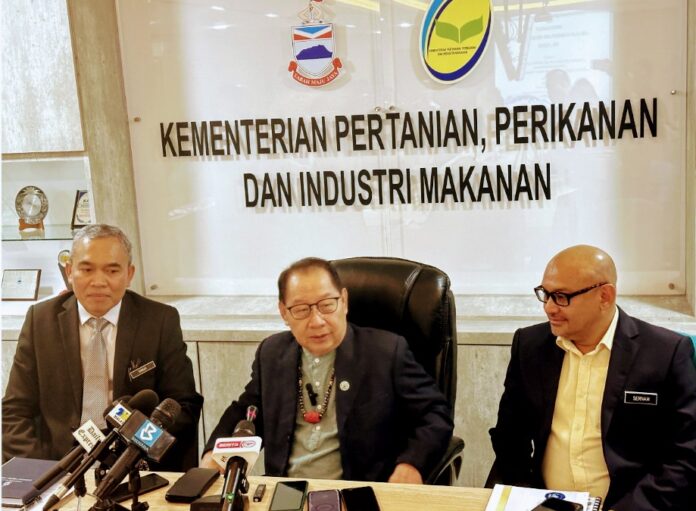Dr Jeffrey speaking to reporters after chairing the State Water Resources Council meeting.
KOTA KINABALU: Several proposals, including the gazetting of water resources as well as the construction of coastal reservoirs and tube wells, have been put forth to address the ongoing and incoming water issues in Sabah, especially in light of the drought season.
Deputy Chief Minister I Datuk Seri Dr Jeffrey Kitingan said the first proposal involves gazetting all water resources areas throughout the state for two purposes, namely protection or conservation.
He said gazetting for protection, specifically in seven districts with water plants that are affected by the current dry and hot weather, would mean the areas cannot be disturbed even though they might be state land or outside of forest reserves.
The seven districts are Tuaran, Papar, Tawau, Sandakan, Semporna, Kudat and Penampang.
He said as for conservation, specifically gazetting surrounding water catchments of these protected areas, it would have some leeway as most of these lands have grants or farms, adding that there is a need for a policy to be drafted to oversee this matter.
“We are suggesting for seven districts here to be gazetted as protected areas, while the rest as conservation areas. This will be brought forth to the State Government so that it can be implemented immediately,” he said.
Jeffrey told reporters this after chairing a State Water Resources Council meeting at Wisma Pertanian here on Friday, where various suggestions and ideas were discussed regarding the state’s water predicament.
He said even though the present dry spell which is caused or made worse by the El Nino phenomenon is an issue that should be swiftly tackled, the opposite of such situation should also be taken into consideration, specifically floods and heavy rainfall.
Hence, he said the second proposal is to take advantage of a potential inverse of the current situation by building coastal reservoirs here to collect excess rainwater or floodwater which can be utilised for various purposes, especially during drought seasons.
“I will bring up the idea of coastal reservoirs to the State Government for due consideration. We would need to conduct a study on how we can implement it.
“I think there is also a need for retention ponds to be built at the upper areas so that we can reduce the amount of floodwater at the lower areas,” he said.
The third proposal, he said, is the construction of tube wells or implementation of water transfers, whereby the latter involves moving excess water from one area to another which lacks the supply, either through mobile pipes or water lorries.
“The State Water Department (JANS) and other relevant departments or agencies will assist in this endeavour. They are currently identifying which areas to implement this tube well or water transfer initiative,” he said.
He also suggested that aside from having Village Development and Security Committees (JKKK), villages in the state should have a committee to oversee the protection and conservation of water resources in their respective areas.
“Such a committee is vital to provide understanding to the people on the importance of protecting our environment and to practice conservation efforts,” he said.
Jeffrey said according to data from JANS, the water levels at all dams in the state had recorded a decrease, with the Babagon Dam’s operating storage volume now down to 69 percent which translates to around 83 more days’ worth of water that it can supply if the hot and dry weather persists.
He said plants that get their water supply from the Babagon Dam are operating as usual according to standard output, and if water levels decreases further, those such as the one in Moyog can still obtain water from the Madsiang water intake to conserve the Babagon Dam’s supply.
However, in the event of water levels at the dams reaching a critical stage, he said there is a big possibility of implementing raw water rationing.
“But for now, the situation is still under control. Water is being supplied as usual. I visited Tambunan recently and found that even though the water level at the nearby river had gone down, water can still be supplied to the plants for our usage such as for drinking water.
“Despite that, the river’s water level has become less suitable for food agriculture activities, which will affect our food production,” he said.
Jeffrey, who is also State Agriculture, Fisheries and Food Industries Minister, explained that as of now, several paddy planting areas throughout the state have been affected by the dry spell following a 40 to 50 percent decrease of water level in rivers here.
He said the affected areas are in Kota Belud (267 acres), Papar (135.12 acres), Membakut (99.66 acres) and admittedly the most concerning, Keningau (5,621.65 acres).
He said a solution for the lack of water in Keningau is to use mobile pumps to channel water from nearby larger rivers to the paddy fields, as opposed to the traditional irrigation method of using gravity water which is unfeasible now due to lower water levels in the smaller rivers.
“Affected in this sense means that the paddy plants are not receiving enough water. Some of the plants that are already at the harvesting stage are not affected but I am more afraid of the coming season.
“Disruption in the state’s production of paddy is expected maybe not this year but in the next planting season. I cannot give an estimate on percentages but the production will definitely go down,” he said. – Borneo Post

